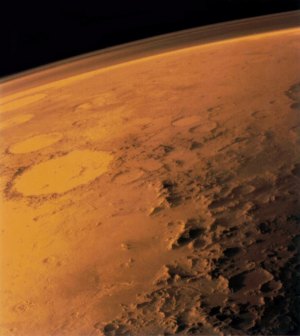Mars In Brief: More evidence of habitable environment as rover chugs onward

NASA image.
Spirit was in operation for six years. Opportunity is still chugging along. Indeed, scientists are detailing more evidence that Mars could have supported life in the distant past. Their research describes findings gleaned using the rovers.
Ray Arvidson, a professor at Washington University in St. Louis and Opportunity's deputy principal investigator, writes in detail about the discoveries made by the rover in the Jan. 24 edition of the journal Science. Rock samples collected and examined by Opportunity have confirmed an ancient wet environment that was milder and older than the acidic and oxidizing conditions told by rocks the rover examined previously, according to NASA.
“These results demonstrate that early Mars was habitable, but this does not mean that Mars was inhabited,” writes John P. Grotzinger, professor in the division of geological and planetary sciences, California Institute of Technology, in an introduction to the journal. “Even for Earth, it was a formidable challenge to prove that microbial life existed billions of years ago—a discovery that occurred almost 100 years after Darwin predicted it, through the recognition of microfossils preserved in silica.”
The annual budget to maintain Opportunity is $14 million, scientists said during a NASA press conference Jan. 23. But Opportunity has given them a solid bang for the buck.
“No one ever expected this, that after 10 years, the Mars exploration rover would continue to operate – and operate productively, on the surface of Mars,” said John Callas, Mars Exploration Rovers project manager for NASA's Jet Propulsion Laboratory. During the past decade, Opportunity has covered 38.7 kilometers, about 24 miles. It has weathered 3,500 Martian days, collecting 170,000 images.
After 10 years, it is in good health, Callas added. That’s not to say it couldn’t use a tuneup. “It no longer steers. …The robotic arm has some arthritis to it, two of the scientific instruments no longer function.”
Recently, the rover had a “senior moment,” Callas said. There was an “amnesia event” with the flash file system. If it gets worse, scientists will take corrective action.
Beyond the scientific insights about Mars, the rovers have given humanity an intangible, “something different, something special,” Callas said. “Over the past decade, through these rovers, our species has gone to work on Mars. And now a generation has grown up with these rovers and been inspired by them. And some of these people are working on this mission today, are working on Mars.”
The rovers have allowed us to see another world. As Callas put it, we are “dual citizens, if you will. We now live in a larger world, a world that extends beyond our own home planet. These rovers have made Mars our neighborhood and our backyard. This is something truly remarkable.”
Related:

